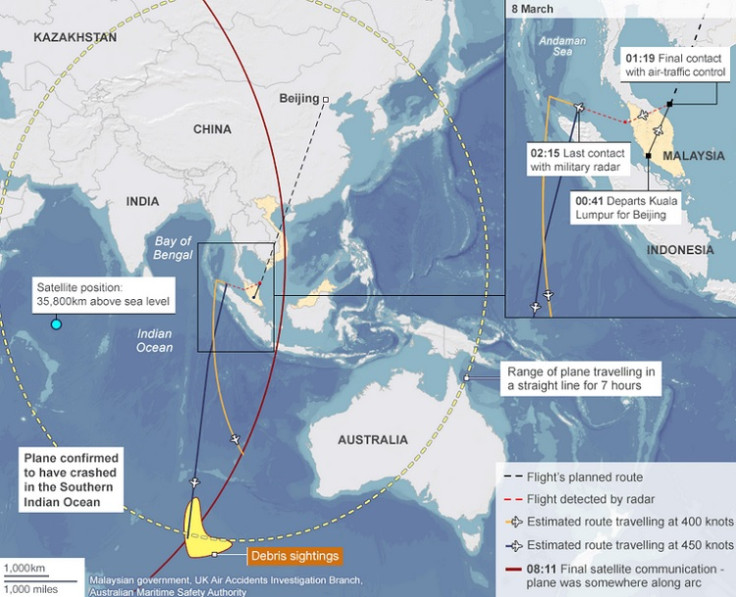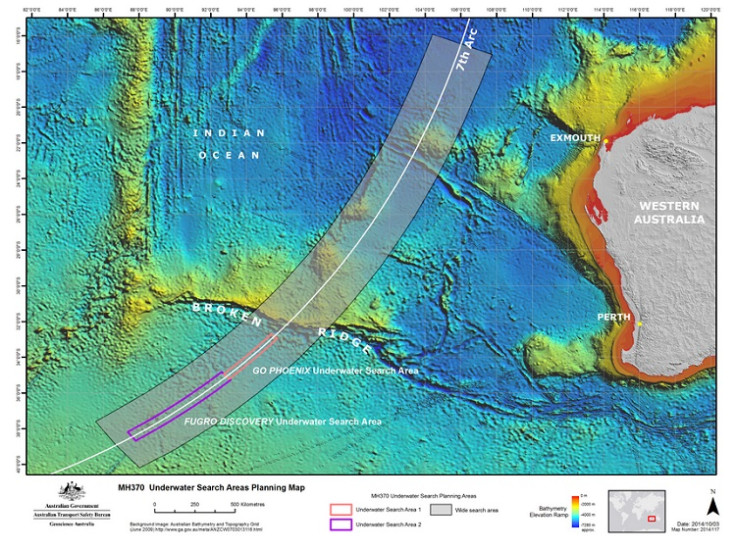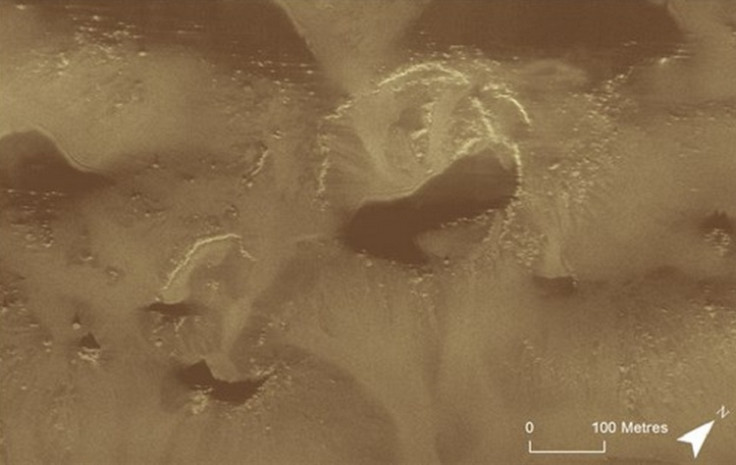Missing Malaysia Airlines Flight MH370: Facts revealed on the biggest aviation mystery in history

As uncertainty mounts over the whereabouts of missing AirAsia flight, IBTimes UK looks back at the disappearance of Malaysia Airlines flight MH370 - one of the biggest aviation mysteries of all time.
On 8 March 2014, hundreds of passengers waved goodbye to their loved-ones before boarding their flights from Kuala Lumpur International Airport to destinations across the world.
But for those families of the 239 people getting on board the doomed MH370 flight it was the last time they would ever see their relatives.
The flight departed Kuala Lumpur at 12.41am local time, (4.41pm GMT, 7 March) and was due to land in Beijing at 6.30am, (10.30pm GMT on 8 March). But it never arrived.
For unknown reasons to this day, this particular Boeing 777 veered off its original flight path and did not send any distress signal, similar to flight QZ8501.
Authorities now believe MH370 is lying somewhere at the bottom of the southern Indian Ocean.
But nine months later, still no trace of the plane has ever been discovered; no sign of its wreckage has even been spotted washed ashore, leaving grieving families with no closure as to what happened to their loved-ones, only countless theories to cling on to for hope.
"I haven't grieved yet," said Sarah Bajc, a New Zealander, whose American partner Philip Wood was on aboard the MH370. "I haven't accepted that he is dead...I owe it to him to find out the truth."
What do we know?

Data analysis
Experts say analysis of satellite data shows the MH370 ended its journey in the southern Indian Ocean along what has been identified as the "seventh arc" off the west coast of Australia.
Search areas
The search for the missing plane started in the South China Sea. It involved 14 countries, 43 ships, and 58 aircraft. At its largest covered 7.68 million sq km (2.96 million sq miles) - equivalent to 1.5% of the earth's surface.
On 16 March, data released by the Malaysian authorities confirmed the plane crashed in the Indian Ocean. Different areas were identified and have since been ruled out including where the satellite pings via the plane were detected.

On 26 June, the Australian Transport Safety Bureau identified a new refined search area of 60,000 sq km located 1,100 miles off Perth.
Over 9,000 sq km (5,592 miles) of ocean floor has now been scoured and about 200,000 sq km (124, 274 miles) of the search area surveyed by the Fugro equator vessel, according to the ATSB. Other search ships include the GO Phoenix and Fugro Discovery.

This sonic image was released earlier in December and was said to reveal "important" details of the ocean floor which would help in the search for the missing plane.

But there still has been no sign of any wreckage. Aviation experts have said missing flight QZ8501 might be more easily found in the shallow seas of the Java Sea, compared to the task that search teams face hunting for the MH370 in the deep waters of the Indian Ocean.
Fugro Survey, the Dutch company contracted by the Australian authorities to lead the deep sea investigation anticipated the latest mission, costing £34m ($55m), to last 12 months. But the authorities are expecting to extend it until May 2015 following a technical issue on board search ship Fugro Discovery.
Timeline of events after MH370 vanished from radar

12.41am: The MH370 flight departed from Kuala Lumpur. Malaysian Airlines lost contact with the airliner less than an hour after take-off. No distress signal was sent.
1.07am: The last ACARS, (Aircraft and Communications Addressing and Reporting System) transmission was sent via the plane's computers to computers on the ground but the expected 1.37am transmission was never sent.
Malaysia Prime Minister Najib Razak later said it was believed the plane's transponder, which emits an identifying signal was was "deliberately disabled" before the plane changed course and continued flying for a further seven hours. He told a news conference: "Movements are consistent with the deliberate action of someone on the plane", although refused to label it a hijacking.
1.19am: Last communication between the plane and ground staff where the pilot or co-pilot is heard saying: "Goodnight Malaysian three seven zero."
1.21am: The civil authority of Vietnam said the plane failed to check-in with ground staff as scheduled in the city of Ho Chi Minh City.
2.15am: Malaysian military traced the MH370 to a point south of Phuket island in the Strait of Malacca - west of its last known location. Thai military also confirmed the plane had turned west then north over the Andaman Sea. But the Malaysian government revised the time to be 2.22am and put the flight's path further west.

Razak later admitted the military failed to act because "it was not deemed hostile" and said it was not sure it was MH370 so declined to send jets across the southern Indian ocean to investigate.
Bryon Bailey, a former Boeing pilot, has questioned how the Indian and Indonesian military also failed to track the MH370 and also believed the plane's systems were sabotaged.
2.28am: After radar was lost, data was picked up between the plane and a ground station via a satellite above the Indian Ocean (identified by British company, Inmarsat) which converted into seven automatic "hand shakes" or so-called "pings", which later enabled the firm to calculate two possible routes the plane had flown in: the northern corridor between Thailand and Kazakhstan, and the southern corridor between Indonesia and the southern Indian Ocean.

Who were the people on board?
There were 227 passengers, 153 Chinese, 38 Malaysians - 12 of which were crew members led by pilots captain Zaharie Ahmed Shah, 53, and co-pilot Fariq Abdul Hamid, 27. Other passengers were from Iran, US, Canada, Indonesia, Australia, India, France, New Zealand, Ukraine, Russia, Taiwan and the Netherlands.
Two Iranian men, Pouria Nour Mohammad Mehrdad, 19, and Delavar Seyed Mohammadreza, 29, were discovered to be travelling to Europe via Beijing with false passports but there were no apparent terrorist links.
Among the Chinese nationals there were 19 prominent artists who attended an exhibition in Kuala Lumpur.
There were 20 employees from Freescale Semiconductor, technology firm, which produces aeronautical hardware technology with radar-blocking capabilities. Twelve employees were Malaysian and eight Chinese. A conspiracy theory emerged shortly after the plane went missing. An anonymous author wrote on citizen news site beforeitsnews: "It's conceivable that the Malaysia Airlines Flight MH370 is 'cloaked', hiding with high-tech electronic warfare weaponary that exists and is used."
Other conspiracy theories
Without any concrete answers or news about the whereabouts of the plane from the authorities it has left ample room for conspiracy theories to fill the void and give some explanation for the disappearance of MH370. The theories range from captain Shah using the plane for a suicide mission, to most recently the plane being shot down by the US military.
© Copyright IBTimes 2025. All rights reserved.






















